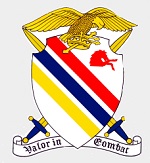Legion LEG14606LD USAAF North American P-51B Mustang Fighter - Maj. James Howard, "Ding Hao!," 356th Fighter Squadron, 354th Fighter Group, 1944 (1:72 Scale)
"The day I saw Mustangs over Berlin, I knew the jig was up."
- Reichmarschall Hermann Goering, Head of the German Luftwaffe
 No other aircraft of WWII could fly as high, go as far, or fight as hard as the famed Mustang. Piloted by a record 281 Aces, this agile and ferocious dogfighter tallied more kills than any other Allied airplane. As the bombers of the Eighth Air Force fought their way deep into Hitler's Germany, it was the Mustang that cleared the skies of Luftwaffe fighters. The powerful Rolls-Royce Merlin engine gave the Mustang a speed of 445 mph. Re-styled with an aerodynamic bubble canopy for greater visibility, and outfitted with 6 fast-firing .50 caliber machine guns, the P-51 became the best fighter of the war.
New P-51Bs (NA-102s) would continue with the same armament and ammunition load of the P-51A, while the bomb rack/external drop tank installation was adapted from the A-36 Apache; the racks were rated to carry up to 500 lb (230 kg) of ordnance and were also piped for drop tanks. The machine guns were aimed using the electrically illuminated N-3B reflector sight fitted with an A-1 head assembly which allowed it to be used as a gun or bomb sight through varying the angle of the reflector glass. Pilots were also given the option of having ring and bead sights mounted on the top engine cowling formers. This option was discontinued with the P-51D.
No other aircraft of WWII could fly as high, go as far, or fight as hard as the famed Mustang. Piloted by a record 281 Aces, this agile and ferocious dogfighter tallied more kills than any other Allied airplane. As the bombers of the Eighth Air Force fought their way deep into Hitler's Germany, it was the Mustang that cleared the skies of Luftwaffe fighters. The powerful Rolls-Royce Merlin engine gave the Mustang a speed of 445 mph. Re-styled with an aerodynamic bubble canopy for greater visibility, and outfitted with 6 fast-firing .50 caliber machine guns, the P-51 became the best fighter of the war.
New P-51Bs (NA-102s) would continue with the same armament and ammunition load of the P-51A, while the bomb rack/external drop tank installation was adapted from the A-36 Apache; the racks were rated to carry up to 500 lb (230 kg) of ordnance and were also piped for drop tanks. The machine guns were aimed using the electrically illuminated N-3B reflector sight fitted with an A-1 head assembly which allowed it to be used as a gun or bomb sight through varying the angle of the reflector glass. Pilots were also given the option of having ring and bead sights mounted on the top engine cowling formers. This option was discontinued with the P-51D.
The first XP-51B flew on November 30th, 1942. Flight tests confirmed the potential of the new fighter, with the service ceiling being raised by 10,000 ft (3,000 m), with the top speed improving by 50 mph (43 kn; 80 km/h) at 30,000 ft (9,100 m). American production was started in early 1943 with the P-51B (NA-102) being manufactured at Inglewood, California, and the P-51C (NA-103) at a new plant in Dallas, Texas, which was in operation by summer 1943. The RAF named these models Mustang Mk III. In performance tests, the P-51B reached 441 mph (383 kn; 710 km/h) at 30,000 ft (9,100 m). In addition, the extended range made possible by the use of drop tanks enabled the Merlin-powered Mustang to be introduced as a bomber escort with a combat radius of 750 mi (1,210 km) using two 75 US gal (62 imp gal; 280 l) 2-piece, sheet-metal stamped construction drop tanks.
Pictured here is a 1:72 scale replica of a USAAF North American P-51B Mustang fighter that was piloted by Maj. James Howard, and nicknamed "Ding Hao!," which was attached to the 356th Fighter Squadron, 354th Fighter Group, during 1944.
Now in stock!
Dimensions:
Wingspan: 6-3/4-inches
Length: 5-inches
Release Date: September 2024
 Historical Account: "Ding Hao" - Lt. Col. James Howard flew a P-51B Mustang, nicknamed 'Ding Hao', when he was Commanding Officer of the 354th Fighter Group. He flew with the American Fighter Group, known as the 'Flying Tigers', in China until the unit disbanded on July 4th, 1942. He then he joined the 356th Fighter Squadron, 354th Fighter Group, 9th USAAF, in England. While he was with the Flying Tigers, he was credited with 2.33 air-to-air and four air-to-ground victories, and his total of 8.33 air-to-air kills made him an Ace. On January 11th, 1944, he single-handedly defended a formation of B-17 bombers from the 401st Bomb Group against an estimated 30-40 German fighters northwest of Halberstadt, Germany. For his efforts on this mission, he was awarded the Congressional Medal of Honor, the only fighter pilot in northwestern Europe to receive the nation's highest honor.
Historical Account: "Ding Hao" - Lt. Col. James Howard flew a P-51B Mustang, nicknamed 'Ding Hao', when he was Commanding Officer of the 354th Fighter Group. He flew with the American Fighter Group, known as the 'Flying Tigers', in China until the unit disbanded on July 4th, 1942. He then he joined the 356th Fighter Squadron, 354th Fighter Group, 9th USAAF, in England. While he was with the Flying Tigers, he was credited with 2.33 air-to-air and four air-to-ground victories, and his total of 8.33 air-to-air kills made him an Ace. On January 11th, 1944, he single-handedly defended a formation of B-17 bombers from the 401st Bomb Group against an estimated 30-40 German fighters northwest of Halberstadt, Germany. For his efforts on this mission, he was awarded the Congressional Medal of Honor, the only fighter pilot in northwestern Europe to receive the nation's highest honor.


